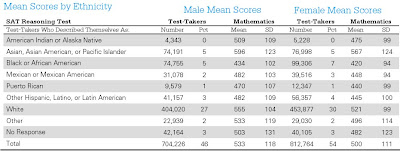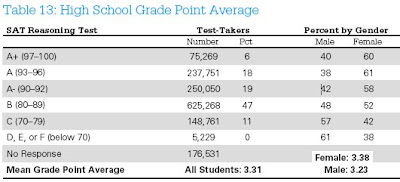
From the Supporting Online Material for "Gender Similarities Characterize Math Performance," published in Science Magazine, July 2008:
Gender differences in performance on the SAT Mathematics test are widely publicized and contribute to the public’s view that males excel in mathematics, compared with females. In 2007, males scored an average of 533 ± 114 (mean ± SD = 114) on the Mathematics portion of the SAT, compared with an average of 499 ± 111 for girls. For many reasons, these data tell us nothing about gender differences in mathematics performance. Chief among these reasons is sampling. The SAT is taken almost exclusively by college-bound students, and even then, some college-bound students do not take it because their intended college requires some other test such as the ACT. Therefore, there is no well-defined sampling frame that would permit broader generalization. Perhaps more important is the fact that, coupled with the current trend for more females than males to attend college, the SAT is taken by more females than males.
In 2007 the SAT was taken by 798,030 females but only 690,500 males, a gap of more than 100,000 people. Assuming that SAT takers represent the top portion of the performance distribution, this surplus of females taking the SAT means that the female group dips farther down into the performance distribution than does the male group. It is therefore not surprising that females, on average, score somewhat lower than males. The gender gap is likely in large part a sampling artifact.
MP: In an email, Greg Mankiw also made this observation, and so did Junkyard_Hawg1985 in several comments on this CD post. I'm not completely convinced that a difference in sample sizes could account for such a large difference in mean SAT math test scores (+30 points in all years). And that 30+ point male-female math test score gap existed even back in 1971 when the sample size issue was probably reversed: more men probably took the test back then than women, and it was probably the male group that "dipped further down into the performance distribution" than the female group.
But even putting aside the issue of possible gender differences in mean SAT scores, we are still left with the huge gender disparity in math performance at the highest levels, which would have nothing to do with the sample size issue, and would have everything to do with the gender differences in the variability of test performance and/or intelligence.
As the table above shows, males outnumber females by almost 2 to 1 for SAT math test scores above 750, and by 1.6 males to 1 female for test scores between 700-740. For the 650-690 range, males outnumber females by a factor of 1.38 to 1, and for the 600-640 range the ratio is 1:15 males to every female. For all of the other ranges except the bottom one, females outnumber males. So we are still left with the outcome of superior male math performance, at least at the highest levels of achievement, if not on an average basis.
Then what about the issue of complete female dominance over males for the writing portion of the SAT exam, with a significantly higher mean score and overrepresentation at all of the highest score levels?










































